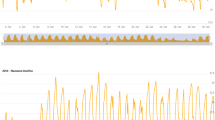Abstract
Seven fungi associated with fruit rot of tomato were isolated includingFusarium equiseti, F. chlamydosporum, Alternaria solani, Geotrichum candidum, Acremonium recifei, Aspergillus flavus andA. niger. They were all pathogenic on tomato fruits, most pathogenic beingGeotrichum candidum followed byA. niger. Least rot was caused byAlternaria solani. The optimum temperature for maximum rotting caused byG. candidum, A. niger andA. flavus was 30°C. The relative humidity for maximum rot ranged from 70–90%. Tomato fruits stored well at 0–10°C and rather poorly at 20–30°C. Fruits stored at 35°C showed blemishes. The best RH for storage ranged between 60 and 90%.
Similar content being viewed by others
References
Ramsey GB, Link GKK. Market diseases of fruits and vegetables: Tomatoes, peppers, eggplants. Misc Publ US Department Agric 121, 1932; 44pp.
Quinn JG. An evaluation of methods of mulching and staking tomatoes grown during the rains at Samaru, Nigeria. Samaru Research Bull 221, 1936.
Arinze AE. Post-harvest diseases of tomato fruits in Southern Nigeria. Fitopatol Brass 1986; 11: 637–645.
Ashworth LJ, King WR. Etiology of tomato fruit rot in the Red River Valley of Texas. Phytopathology 1962; 52: 723.
Gonzales LC, Owen JH. Soil rot of tomato canned byR. solani. Phytopathology 1963; 53: 82–85.
Butler EE. Fungi and rots in California canning tomatoes. Plt Dis Reptr 1959; 43: 187–192.
Butler EE. Pathogenicity and taxonomy ofGeotrichum candidum. Phytopathology 1960; 50: 665–672.
Chupp C, Sherf AF. Vegetable diseases and their control. New York: Ronald Press, 1960; 693 pp.
Solomon ME. Control of humidity with potassium hydroxide, sulphuric acid and other solutions. Bull Entomol Res 1951; 42: 543–554.
Doolittle SP, Taylor AL, Danielson LL. Tomato diseases and their control. US Department Agric. Handbook 203, 1961, 86 pp.
Nightingale AA, Ramsey GB. Tempersature studies of some tomato pathogens. US Dept Agric Tech Bull 520, 1936; 36pp.
Butler EE. Transmission ofGeotrichum rot of tomato fruit byDrosophila melanogaster. Phytopathol 1961; 51: 250–255.
Carmichael JW.Geotrichum candidum. Mycologia 1957; 49: 820–830.
Author information
Authors and Affiliations
Rights and permissions
About this article
Cite this article
Oladiran, A.O., Iwu, L.N. Studies on the fungi associated with tomato fruit rots and effects of environment on storage. Mycopathologia 121, 157–161 (1993). https://doi.org/10.1007/BF01104071
Received:
Accepted:
Issue Date:
DOI: https://doi.org/10.1007/BF01104071




